Because we have a microservice project based on Spring Cloud, we know about OAuth2 and plan to integrate OAuth2 to realize unified authorization. OAuth is an open network standard for authorization. The current version is 2.0. I won't introduce it here.
Development environment: Windows10, IntelliJ idea2018 2, jdk1.8, redis3.2.9, Spring Boot 2.0.2 Release, Spring Cloud Finchley.RC2 Spring 5.0.6
Project directory
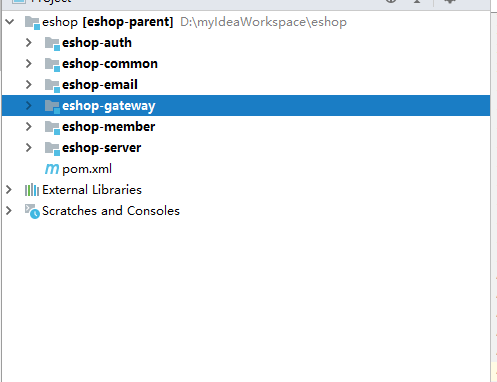
eshop -- parent project, managing jar package version
Eshop server - Eureka service registry
Eshop Gateway - Zuul gateway
Eshop auth -- authorization service
Eshop member - Member Service
Eshop email - mail service (not used yet)
Eshop common -- general class
How to build a basic Spring Cloud microservice will not be repeated here. No, you can take a look at the author's blog about Spring Cloud series.
Here is an entry address: https://blog.csdn.net/wya1993/article/category/7701476
Authorization services
Firstly, build eshop auth service and introduce related dependencies
<?xml version="1.0" encoding="UTF-8"?>
<project xmlns="http://maven.apache.org/POM/4.0.0"
xmlns:xsi="http://www.w3.org/2001/XMLSchema-instance"
xsi:schemaLocation="http://maven.apache.org/POM/4.0.0 http://maven.apache.org/xsd/maven-4.0.0.xsd">
<parent>
<artifactId>eshop-parent</artifactId>
<groupId>com.curise.eshop</groupId>
<version>1.0-SNAPSHOT</version>
</parent>
<modelVersion>4.0.0</modelVersion>
<artifactId>eshop-auth</artifactId>
<packaging>war</packaging>
<description>Authorization module</description>
<dependencies>
<dependency>
<groupId>com.curise.eshop</groupId>
<artifactId>eshop-common</artifactId>
<version>1.0-SNAPSHOT</version>
</dependency>
<dependency>
<groupId>org.springframework.boot</groupId>
<artifactId>spring-boot-starter-web</artifactId>
</dependency>
<dependency>
<groupId>org.springframework.cloud</groupId>
<artifactId>spring-cloud-starter-netflix-eureka-client</artifactId>
</dependency>
<dependency>
<groupId>org.springframework.cloud</groupId>
<artifactId>spring-cloud-starter-oauth2</artifactId>
</dependency>
<dependency>
<groupId>org.springframework.cloud</groupId>
<artifactId>spring-cloud-starter-security</artifactId>
</dependency>
<dependency>
<groupId>org.springframework.boot</groupId>
<artifactId>spring-boot-starter-data-redis</artifactId>
</dependency>
<dependency>
<groupId>org.mybatis.spring.boot</groupId>
<artifactId>mybatis-spring-boot-starter</artifactId>
</dependency>
<dependency>
<groupId>org.springframework.boot</groupId>
<artifactId>spring-boot-starter-actuator</artifactId>
</dependency>
<dependency>
<groupId>mysql</groupId>
<artifactId>mysql-connector-java</artifactId>
</dependency>
<dependency>
<groupId>com.alibaba</groupId>
<artifactId>druid</artifactId>
</dependency>
<dependency>
<groupId>log4j</groupId>
<artifactId>log4j</artifactId>
</dependency>
</dependencies>
<build>
<plugins>
<plugin>
<groupId>org.springframework.boot</groupId>
<artifactId>spring-boot-maven-plugin</artifactId>
</plugin>
</plugins>
</build>
</project>
Next, configure Mybatis, redis and eureka and paste the configuration file
server:
port: 1203
spring:
application:
name: eshop-auth
redis:
database: 0
host: 192.168.0.117
port: 6379
password:
jedis:
pool:
max-active: 8
max-idle: 8
min-idle: 0
datasource:
driver-class-name: com.mysql.jdbc.Driver
url: jdbc:mysql://localhost:3306/eshop_member?useUnicode=true&characterEncoding=utf-8&useSSL=false&allowMultiQueries=true
username: root
password: root
druid:
initialSize: 5 #Initialize connection size
minIdle: 5 #Minimum number of connection pools
maxActive: 20 #Maximum number of connection pools
maxWait: 60000 #Maximum wait time to get a connection, in milliseconds
timeBetweenEvictionRunsMillis: 60000 #Configure how often to detect idle connections that need to be closed. The unit is milliseconds
minEvictableIdleTimeMillis: 300000 #Configure the minimum lifetime of a connection in the pool, in milliseconds
validationQuery: SELECT 1 from DUAL #Test connection
testWhileIdle: true #It is detected when applying for connection. It is recommended to configure it to true, which will not affect performance and ensure security
testOnBorrow: false #The detection is performed when obtaining the connection. It is recommended to close it, which will affect the performance
testOnReturn: false #Perform detection when returning the connection. It is recommended to close it, which will affect the performance
poolPreparedStatements: false #Whether to enable PSCache. PSCache greatly improves the performance of databases supporting cursors. It is recommended to enable it in oracle and close it in mysql
maxPoolPreparedStatementPerConnectionSize: 20 #It takes effect after poolPreparedStatements is enabled
filters: stat,wall,log4j #Configure extensions. Common plug-ins are = > stat: monitoring statistics log4j: log wall: defending sql injection
connectionProperties: 'druid.stat.mergeSql=true;druid.stat.slowSqlMillis=5000' #Open the mergeSql function through the connectProperties property; Slow SQL record
eureka:
instance:
prefer-ip-address: true
instance-id: ${spring.cloud.client.ip-address}:${server.port}
client:
service-url:
defaultZone: http://localhost:1111/eureka/
mybatis:
type-aliases-package: com.curise.eshop.common.entity
configuration:
map-underscore-to-camel-case: true #Open hump naming, l_ name -> lName
jdbc-type-for-null: NULL
lazy-loading-enabled: true
aggressive-lazy-loading: true
cache-enabled: true #Enable L2 cache
call-setters-on-nulls: true #map empty columns do not show problems
mapper-locations:
- classpath:mybatis/*.xml
AuthApplication adds @ EnableDiscoveryClient and @ MapperScan annotations.
Next, configure the authentication server AuthorizationServerConfig, and add @ Configuration and @ EnableAuthorizationServer annotations. The ClientDetailsServiceConfigurer is configured in memory. Of course, it can also be read from the database, which will be improved gradually in the future.
@Configuration
@EnableAuthorizationServer
public class AuthorizationServerConfig extends AuthorizationServerConfigurerAdapter {
@Autowired
private AuthenticationManager authenticationManager;
@Autowired
private DataSource dataSource;
@Autowired
private RedisConnectionFactory redisConnectionFactory;
@Autowired
private MyUserDetailService userDetailService;
@Bean
public TokenStore tokenStore() {
return new RedisTokenStore(redisConnectionFactory);
}
@Override
public void configure(AuthorizationServerSecurityConfigurer security) throws Exception {
security
.allowFormAuthenticationForClients()
.tokenKeyAccess("permitAll()")
.checkTokenAccess("isAuthenticated()");
}
@Override
public void configure(ClientDetailsServiceConfigurer clients) throws Exception {
// clients.withClientDetails(clientDetails());
clients.inMemory()
.withClient("android")
.scopes("read")
.secret("android")
.authorizedGrantTypes("password", "authorization_code", "refresh_token")
.and()
.withClient("webapp")
.scopes("read")
.authorizedGrantTypes("implicit")
.and()
.withClient("browser")
.authorizedGrantTypes("refresh_token", "password")
.scopes("read");
}
@Bean
public ClientDetailsService clientDetails() {
return new JdbcClientDetailsService(dataSource);
}
@Bean
public WebResponseExceptionTranslator webResponseExceptionTranslator(){
return new MssWebResponseExceptionTranslator();
}
@Override
public void configure(AuthorizationServerEndpointsConfigurer endpoints) throws Exception {
endpoints.tokenStore(tokenStore())
.userDetailsService(userDetailService)
.authenticationManager(authenticationManager);
endpoints.tokenServices(defaultTokenServices());
//Authentication exception translation
// endpoints.exceptionTranslator(webResponseExceptionTranslator());
}
/**
* <p>Note that when customizing TokenServices, you need to set @ Primary, otherwise an error will be reported</p>
* @return
*/
@Primary
@Bean
public DefaultTokenServices defaultTokenServices(){
DefaultTokenServices tokenServices = new DefaultTokenServices();
tokenServices.setTokenStore(tokenStore());
tokenServices.setSupportRefreshToken(true);
//tokenServices.setClientDetailsService(clientDetails());
// The validity period of the token is set by user. The default is 12 hours
tokenServices.setAccessTokenValiditySeconds(60*60*12);
// refresh_ The default token is 30 days
tokenServices.setRefreshTokenValiditySeconds(60 * 60 * 24 * 7);
return tokenServices;
}
}
In the above configuration, the authenticated token is stored in redis. If you use spring 5 For versions above 0, the following exceptions will be reported when using the default RedisTokenStore authentication:
nested exception is java.lang.NoSuchMethodError: org.springframework.data.redis.connection.RedisConnection.set([B[B)V
The reason is that in spring data redis version 2.0, set(String,String) is discarded and redisconnection is used stringCommands(). Set (...), I customize a RedisTokenStore. The code is the same as RedisTokenStore, except that all conn.set(...) are replaced by Conn stringCommands(). Set (...), the method is feasible after test.
public class RedisTokenStore implements TokenStore {
private static final String ACCESS = "access:";
private static final String AUTH_TO_ACCESS = "auth_to_access:";
private static final String AUTH = "auth:";
private static final String REFRESH_AUTH = "refresh_auth:";
private static final String ACCESS_TO_REFRESH = "access_to_refresh:";
private static final String REFRESH = "refresh:";
private static final String REFRESH_TO_ACCESS = "refresh_to_access:";
private static final String CLIENT_ID_TO_ACCESS = "client_id_to_access:";
private static final String UNAME_TO_ACCESS = "uname_to_access:";
private final RedisConnectionFactory connectionFactory;
private AuthenticationKeyGenerator authenticationKeyGenerator = new DefaultAuthenticationKeyGenerator();
private RedisTokenStoreSerializationStrategy serializationStrategy = new JdkSerializationStrategy();
private String prefix = "";
public RedisTokenStore(RedisConnectionFactory connectionFactory) {
this.connectionFactory = connectionFactory;
}
public void setAuthenticationKeyGenerator(AuthenticationKeyGenerator authenticationKeyGenerator) {
this.authenticationKeyGenerator = authenticationKeyGenerator;
}
public void setSerializationStrategy(RedisTokenStoreSerializationStrategy serializationStrategy) {
this.serializationStrategy = serializationStrategy;
}
public void setPrefix(String prefix) {
this.prefix = prefix;
}
private RedisConnection getConnection() {
return this.connectionFactory.getConnection();
}
private byte[] serialize(Object object) {
return this.serializationStrategy.serialize(object);
}
private byte[] serializeKey(String object) {
return this.serialize(this.prefix + object);
}
private OAuth2AccessToken deserializeAccessToken(byte[] bytes) {
return (OAuth2AccessToken)this.serializationStrategy.deserialize(bytes, OAuth2AccessToken.class);
}
private OAuth2Authentication deserializeAuthentication(byte[] bytes) {
return (OAuth2Authentication)this.serializationStrategy.deserialize(bytes, OAuth2Authentication.class);
}
private OAuth2RefreshToken deserializeRefreshToken(byte[] bytes) {
return (OAuth2RefreshToken)this.serializationStrategy.deserialize(bytes, OAuth2RefreshToken.class);
}
private byte[] serialize(String string) {
return this.serializationStrategy.serialize(string);
}
private String deserializeString(byte[] bytes) {
return this.serializationStrategy.deserializeString(bytes);
}
@Override
public OAuth2AccessToken getAccessToken(OAuth2Authentication authentication) {
String key = this.authenticationKeyGenerator.extractKey(authentication);
byte[] serializedKey = this.serializeKey(AUTH_TO_ACCESS + key);
byte[] bytes = null;
RedisConnection conn = this.getConnection();
try {
bytes = conn.get(serializedKey);
} finally {
conn.close();
}
OAuth2AccessToken accessToken = this.deserializeAccessToken(bytes);
if (accessToken != null) {
OAuth2Authentication storedAuthentication = this.readAuthentication(accessToken.getValue());
if (storedAuthentication == null || !key.equals(this.authenticationKeyGenerator.extractKey(storedAuthentication))) {
this.storeAccessToken(accessToken, authentication);
}
}
return accessToken;
}
@Override
public OAuth2Authentication readAuthentication(OAuth2AccessToken token) {
return this.readAuthentication(token.getValue());
}
@Override
public OAuth2Authentication readAuthentication(String token) {
byte[] bytes = null;
RedisConnection conn = this.getConnection();
try {
bytes = conn.get(this.serializeKey("auth:" + token));
} finally {
conn.close();
}
OAuth2Authentication auth = this.deserializeAuthentication(bytes);
return auth;
}
@Override
public OAuth2Authentication readAuthenticationForRefreshToken(OAuth2RefreshToken token) {
return this.readAuthenticationForRefreshToken(token.getValue());
}
public OAuth2Authentication readAuthenticationForRefreshToken(String token) {
RedisConnection conn = getConnection();
try {
byte[] bytes = conn.get(serializeKey(REFRESH_AUTH + token));
OAuth2Authentication auth = deserializeAuthentication(bytes);
return auth;
} finally {
conn.close();
}
}
@Override
public void storeAccessToken(OAuth2AccessToken token, OAuth2Authentication authentication) {
byte[] serializedAccessToken = serialize(token);
byte[] serializedAuth = serialize(authentication);
byte[] accessKey = serializeKey(ACCESS + token.getValue());
byte[] authKey = serializeKey(AUTH + token.getValue());
byte[] authToAccessKey = serializeKey(AUTH_TO_ACCESS + authenticationKeyGenerator.extractKey(authentication));
byte[] approvalKey = serializeKey(UNAME_TO_ACCESS + getApprovalKey(authentication));
byte[] clientId = serializeKey(CLIENT_ID_TO_ACCESS + authentication.getOAuth2Request().getClientId());
RedisConnection conn = getConnection();
try {
conn.openPipeline();
conn.stringCommands().set(accessKey, serializedAccessToken);
conn.stringCommands().set(authKey, serializedAuth);
conn.stringCommands().set(authToAccessKey, serializedAccessToken);
if (!authentication.isClientOnly()) {
conn.rPush(approvalKey, serializedAccessToken);
}
conn.rPush(clientId, serializedAccessToken);
if (token.getExpiration() != null) {
int seconds = token.getExpiresIn();
conn.expire(accessKey, seconds);
conn.expire(authKey, seconds);
conn.expire(authToAccessKey, seconds);
conn.expire(clientId, seconds);
conn.expire(approvalKey, seconds);
}
OAuth2RefreshToken refreshToken = token.getRefreshToken();
if (refreshToken != null && refreshToken.getValue() != null) {
byte[] refresh = serialize(token.getRefreshToken().getValue());
byte[] auth = serialize(token.getValue());
byte[] refreshToAccessKey = serializeKey(REFRESH_TO_ACCESS + token.getRefreshToken().getValue());
conn.stringCommands().set(refreshToAccessKey, auth);
byte[] accessToRefreshKey = serializeKey(ACCESS_TO_REFRESH + token.getValue());
conn.stringCommands().set(accessToRefreshKey, refresh);
if (refreshToken instanceof ExpiringOAuth2RefreshToken) {
ExpiringOAuth2RefreshToken expiringRefreshToken = (ExpiringOAuth2RefreshToken) refreshToken;
Date expiration = expiringRefreshToken.getExpiration();
if (expiration != null) {
int seconds = Long.valueOf((expiration.getTime() - System.currentTimeMillis()) / 1000L)
.intValue();
conn.expire(refreshToAccessKey, seconds);
conn.expire(accessToRefreshKey, seconds);
}
}
}
conn.closePipeline();
} finally {
conn.close();
}
}
private static String getApprovalKey(OAuth2Authentication authentication) {
String userName = authentication.getUserAuthentication() == null ? "": authentication.getUserAuthentication().getName();
return getApprovalKey(authentication.getOAuth2Request().getClientId(), userName);
}
private static String getApprovalKey(String clientId, String userName) {
return clientId + (userName == null ? "" : ":" + userName);
}
@Override
public void removeAccessToken(OAuth2AccessToken accessToken) {
this.removeAccessToken(accessToken.getValue());
}
@Override
public OAuth2AccessToken readAccessToken(String tokenValue) {
byte[] key = serializeKey(ACCESS + tokenValue);
byte[] bytes = null;
RedisConnection conn = getConnection();
try {
bytes = conn.get(key);
} finally {
conn.close();
}
OAuth2AccessToken accessToken = deserializeAccessToken(bytes);
return accessToken;
}
public void removeAccessToken(String tokenValue) {
byte[] accessKey = serializeKey(ACCESS + tokenValue);
byte[] authKey = serializeKey(AUTH + tokenValue);
byte[] accessToRefreshKey = serializeKey(ACCESS_TO_REFRESH + tokenValue);
RedisConnection conn = getConnection();
try {
conn.openPipeline();
conn.get(accessKey);
conn.get(authKey);
conn.del(accessKey);
conn.del(accessToRefreshKey);
// Don't remove the refresh token - it's up to the caller to do that
conn.del(authKey);
List<Object> results = conn.closePipeline();
byte[] access = (byte[]) results.get(0);
byte[] auth = (byte[]) results.get(1);
OAuth2Authentication authentication = deserializeAuthentication(auth);
if (authentication != null) {
String key = authenticationKeyGenerator.extractKey(authentication);
byte[] authToAccessKey = serializeKey(AUTH_TO_ACCESS + key);
byte[] unameKey = serializeKey(UNAME_TO_ACCESS + getApprovalKey(authentication));
byte[] clientId = serializeKey(CLIENT_ID_TO_ACCESS + authentication.getOAuth2Request().getClientId());
conn.openPipeline();
conn.del(authToAccessKey);
conn.lRem(unameKey, 1, access);
conn.lRem(clientId, 1, access);
conn.del(serialize(ACCESS + key));
conn.closePipeline();
}
} finally {
conn.close();
}
}
@Override
public void storeRefreshToken(OAuth2RefreshToken refreshToken, OAuth2Authentication authentication) {
byte[] refreshKey = serializeKey(REFRESH + refreshToken.getValue());
byte[] refreshAuthKey = serializeKey(REFRESH_AUTH + refreshToken.getValue());
byte[] serializedRefreshToken = serialize(refreshToken);
RedisConnection conn = getConnection();
try {
conn.openPipeline();
conn.stringCommands().set(refreshKey, serializedRefreshToken);
conn.stringCommands().set(refreshAuthKey, serialize(authentication));
if (refreshToken instanceof ExpiringOAuth2RefreshToken) {
ExpiringOAuth2RefreshToken expiringRefreshToken = (ExpiringOAuth2RefreshToken) refreshToken;
Date expiration = expiringRefreshToken.getExpiration();
if (expiration != null) {
int seconds = Long.valueOf((expiration.getTime() - System.currentTimeMillis()) / 1000L)
.intValue();
conn.expire(refreshKey, seconds);
conn.expire(refreshAuthKey, seconds);
}
}
conn.closePipeline();
} finally {
conn.close();
}
}
@Override
public OAuth2RefreshToken readRefreshToken(String tokenValue) {
byte[] key = serializeKey(REFRESH + tokenValue);
byte[] bytes = null;
RedisConnection conn = getConnection();
try {
bytes = conn.get(key);
} finally {
conn.close();
}
OAuth2RefreshToken refreshToken = deserializeRefreshToken(bytes);
return refreshToken;
}
@Override
public void removeRefreshToken(OAuth2RefreshToken refreshToken) {
this.removeRefreshToken(refreshToken.getValue());
}
public void removeRefreshToken(String tokenValue) {
byte[] refreshKey = serializeKey(REFRESH + tokenValue);
byte[] refreshAuthKey = serializeKey(REFRESH_AUTH + tokenValue);
byte[] refresh2AccessKey = serializeKey(REFRESH_TO_ACCESS + tokenValue);
byte[] access2RefreshKey = serializeKey(ACCESS_TO_REFRESH + tokenValue);
RedisConnection conn = getConnection();
try {
conn.openPipeline();
conn.del(refreshKey);
conn.del(refreshAuthKey);
conn.del(refresh2AccessKey);
conn.del(access2RefreshKey);
conn.closePipeline();
} finally {
conn.close();
}
}
@Override
public void removeAccessTokenUsingRefreshToken(OAuth2RefreshToken refreshToken) {
this.removeAccessTokenUsingRefreshToken(refreshToken.getValue());
}
private void removeAccessTokenUsingRefreshToken(String refreshToken) {
byte[] key = serializeKey(REFRESH_TO_ACCESS + refreshToken);
List<Object> results = null;
RedisConnection conn = getConnection();
try {
conn.openPipeline();
conn.get(key);
conn.del(key);
results = conn.closePipeline();
} finally {
conn.close();
}
if (results == null) {
return;
}
byte[] bytes = (byte[]) results.get(0);
String accessToken = deserializeString(bytes);
if (accessToken != null) {
removeAccessToken(accessToken);
}
}
@Override
public Collection<OAuth2AccessToken> findTokensByClientIdAndUserName(String clientId, String userName) {
byte[] approvalKey = serializeKey(UNAME_TO_ACCESS + getApprovalKey(clientId, userName));
List<byte[]> byteList = null;
RedisConnection conn = getConnection();
try {
byteList = conn.lRange(approvalKey, 0, -1);
} finally {
conn.close();
}
if (byteList == null || byteList.size() == 0) {
return Collections.<OAuth2AccessToken> emptySet();
}
List<OAuth2AccessToken> accessTokens = new ArrayList<OAuth2AccessToken>(byteList.size());
for (byte[] bytes : byteList) {
OAuth2AccessToken accessToken = deserializeAccessToken(bytes);
accessTokens.add(accessToken);
}
return Collections.<OAuth2AccessToken> unmodifiableCollection(accessTokens);
}
@Override
public Collection<OAuth2AccessToken> findTokensByClientId(String clientId) {
byte[] key = serializeKey(CLIENT_ID_TO_ACCESS + clientId);
List<byte[]> byteList = null;
RedisConnection conn = getConnection();
try {
byteList = conn.lRange(key, 0, -1);
} finally {
conn.close();
}
if (byteList == null || byteList.size() == 0) {
return Collections.<OAuth2AccessToken> emptySet();
}
List<OAuth2AccessToken> accessTokens = new ArrayList<OAuth2AccessToken>(byteList.size());
for (byte[] bytes : byteList) {
OAuth2AccessToken accessToken = deserializeAccessToken(bytes);
accessTokens.add(accessToken);
}
return Collections.<OAuth2AccessToken> unmodifiableCollection(accessTokens);
}
}
Configure resource server
@Configuration
@EnableResourceServer
@Order(3)
public class ResourceServerConfig extends ResourceServerConfigurerAdapter {
@Override
public void configure(HttpSecurity http) throws Exception {
http
.csrf().disable()
.exceptionHandling()
.authenticationEntryPoint((request, response, authException) -> response.sendError(HttpServletResponse.SC_UNAUTHORIZED))
.and()
.requestMatchers().antMatchers("/api/**")
.and()
.authorizeRequests()
.antMatchers("/api/**").authenticated()
.and()
.httpBasic();
}
}
Configure Spring Security
@Configuration
@EnableWebSecurity
@Order(2)
public class SecurityConfig extends WebSecurityConfigurerAdapter {
@Autowired
private MyUserDetailService userDetailService;
@Bean
public PasswordEncoder passwordEncoder() {
//return new BCryptPasswordEncoder();
return new NoEncryptPasswordEncoder();
}
@Override
protected void configure(HttpSecurity http) throws Exception {
http.requestMatchers().antMatchers("/oauth/**")
.and()
.authorizeRequests()
.antMatchers("/oauth/**").authenticated()
.and()
.csrf().disable();
}
@Override
protected void configure(AuthenticationManagerBuilder auth) throws Exception {
auth.userDetailsService(userDetailService).passwordEncoder(passwordEncoder());
}
/**
* Do not define grant without password_ type
*
* @return
* @throws Exception
*/
@Override
@Bean
public AuthenticationManager authenticationManagerBean() throws Exception {
return super.authenticationManagerBean();
}
}
You can see that ResourceServerConfig has lower priority than SecurityConfig.
Relationship between the two:
-
ResourceServerConfig is used to protect oauth related endpoints and is mainly used for user login (form login,Basic auth)
-
SecurityConfig is used to protect the resources to be opened by oauth. At the same time, it is mainly used for client side and token authentication (Bearer auth)
Therefore, we make SecurityConfig take precedence over ResourceServerConfig, and SecurityConfig does not intercept oauth the resources to be opened. We configure the resources that need token authentication in ResourceServerConfig, that is, the interfaces we provide externally. Therefore, there is a requirement for the interface definitions of all microservices, that is, they all start with / api.
If you don't configure it like this, after you get access_ When token requests each interface, it will report invalid_token prompt.
In addition, because we customize the authentication logic, we need to override UserDetailService
@Service("userDetailService")
public class MyUserDetailService implements UserDetailsService {
@Autowired
private MemberDao memberDao;
@Override
public UserDetails loadUserByUsername(String memberName) throws UsernameNotFoundException {
Member member = memberDao.findByMemberName(memberName);
if (member == null) {
throw new UsernameNotFoundException(memberName);
}
Set<GrantedAuthority> grantedAuthorities = new HashSet<>();
// Availability: true: available false: not available
boolean enabled = true;
// Expiration: true: no expiration; false: expiration
boolean accountNonExpired = true;
// Validity: true: voucher valid false: voucher invalid
boolean credentialsNonExpired = true;
// Lockability: true: unlocked false: locked
boolean accountNonLocked = true;
for (Role role : member.getRoles()) {
//ROLE must be ROLE_ At the beginning, it can be set in the database
GrantedAuthority grantedAuthority = new SimpleGrantedAuthority(role.getRoleName());
grantedAuthorities.add(grantedAuthority);
//Get permission
for (Permission permission : role.getPermissions()) {
GrantedAuthority authority = new SimpleGrantedAuthority(permission.getUri());
grantedAuthorities.add(authority);
}
}
User user = new User(member.getMemberName(), member.getPassword(),
enabled, accountNonExpired, credentialsNonExpired, accountNonLocked, grantedAuthorities);
return user;
}
}
In order to facilitate password verification, I used the non encrypted method and rewritten PasswordEncoder. BCryptPasswordEncoder is recommended for actual development.
public class NoEncryptPasswordEncoder implements PasswordEncoder {
@Override
public String encode(CharSequence charSequence) {
return (String) charSequence;
}
@Override
public boolean matches(CharSequence charSequence, String s) {
return s.equals((String) charSequence);
}
}
In addition, OAuth's password mode requires authentication manager support
@Override
@Bean
public AuthenticationManager authenticationManagerBean() throws Exception {
return super.authenticationManagerBean();
}
Define a Controller and provide two interfaces, / api/member is used to obtain the current user information, and / api/exit is used to log off the current user
@RestController
@RequestMapping("/api")
public class MemberController {
@Autowired
private MyUserDetailService userDetailService;
@Autowired
private ConsumerTokenServices consumerTokenServices;
@GetMapping("/member")
public Principal user(Principal member) {
return member;
}
@DeleteMapping(value = "/exit")
public Result revokeToken(String access_token) {
Result result = new Result();
if (consumerTokenServices.revokeToken(access_token)) {
result.setCode(ResultCode.SUCCESS.getCode());
result.setMessage("Logout succeeded");
} else {
result.setCode(ResultCode.FAILED.getCode());
result.setMessage("Logoff failed");
}
return result;
}
}
Member service configuration
Introduce dependency
<?xml version="1.0" encoding="UTF-8"?>
<project xmlns="http://maven.apache.org/POM/4.0.0"
xmlns:xsi="http://www.w3.org/2001/XMLSchema-instance"
xsi:schemaLocation="http://maven.apache.org/POM/4.0.0 http://maven.apache.org/xsd/maven-4.0.0.xsd">
<parent>
<artifactId>eshop-parent</artifactId>
<groupId>com.curise.eshop</groupId>
<version>1.0-SNAPSHOT</version>
</parent>
<modelVersion>4.0.0</modelVersion>
<artifactId>eshop-member</artifactId>
<packaging>war</packaging>
<description>Membership module</description>
<dependencies>
<dependency>
<groupId>org.springframework.boot</groupId>
<artifactId>spring-boot-starter-web</artifactId>
</dependency>
<dependency>
<groupId>org.springframework.boot</groupId>
<artifactId>spring-boot-starter-test</artifactId>
<scope>test</scope>
</dependency>
<dependency>
<groupId>org.springframework.cloud</groupId>
<artifactId>spring-cloud-starter-netflix-eureka-client</artifactId>
</dependency>
<dependency>
<groupId>org.springframework.cloud</groupId>
<artifactId>spring-cloud-starter-oauth2</artifactId>
</dependency>
<dependency>
<groupId>org.springframework.cloud</groupId>
<artifactId>spring-cloud-starter-security</artifactId>
</dependency>
<dependency>
<groupId>com.alibaba</groupId>
<artifactId>fastjson</artifactId>
</dependency>
</dependencies>
<build>
<plugins>
<plugin>
<groupId>org.springframework.boot</groupId>
<artifactId>spring-boot-maven-plugin</artifactId>
</plugin>
</plugins>
</build>
</project>
Configure resource server
@Configuration
@EnableResourceServer
public class ResourceServerConfig extends ResourceServerConfigurerAdapter {
@Override
public void configure(HttpSecurity http) throws Exception {
http
.csrf().disable()
.exceptionHandling()
.authenticationEntryPoint((request, response, authException) -> response.sendError(HttpServletResponse.SC_UNAUTHORIZED))
.and()
.requestMatchers().antMatchers("/api/**")
.and()
.authorizeRequests()
.antMatchers("/api/**").authenticated()
.and()
.httpBasic();
}
}
Profile configuration
spring:
application:
name: eshop-member
server:
port: 1201
eureka:
instance:
prefer-ip-address: true
instance-id: ${spring.cloud.client.ip-address}:${server.port}
client:
service-url:
defaultZone: http://localhost:1111/eureka/
security:
oauth2:
resource:
id: eshop-member
user-info-uri: http://localhost:1202/auth/api/member
prefer-token-info: false
MemberApplication main class configuration
@SpringBootApplication
@EnableDiscoveryClient
@EnableGlobalMethodSecurity(prePostEnabled = true)
public class MemberApplication {
public static void main(String[] args) {
SpringApplication.run(MemberApplication.class,args);
}
}
Provide external interface
@RestController
@RequestMapping("/api")
public class MemberController {
@GetMapping("hello")
@PreAuthorize("hasAnyAuthority('hello')")
public String hello(){
return "hello";
}
@GetMapping("current")
public Principal user(Principal principal) {
return principal;
}
@GetMapping("query")
@PreAuthorize("hasAnyAuthority('query')")
public String query() {
return "have query jurisdiction";
}
}
configure gateway
Introduce dependency
<?xml version="1.0" encoding="UTF-8"?>
<project xmlns="http://maven.apache.org/POM/4.0.0"
xmlns:xsi="http://www.w3.org/2001/XMLSchema-instance"
xsi:schemaLocation="http://maven.apache.org/POM/4.0.0 http://maven.apache.org/xsd/maven-4.0.0.xsd">
<parent>
<artifactId>eshop-parent</artifactId>
<groupId>com.curise.eshop</groupId>
<version>1.0-SNAPSHOT</version>
</parent>
<modelVersion>4.0.0</modelVersion>
<packaging>jar</packaging>
<artifactId>eshop-gateway</artifactId>
<description>gateway</description>
<dependencies>
<dependency>
<groupId>org.springframework.boot</groupId>
<artifactId>spring-boot-starter-web</artifactId>
</dependency>
<dependency>
<groupId>org.springframework.cloud</groupId>
<artifactId>spring-cloud-starter-netflix-eureka-client</artifactId>
</dependency>
<dependency>
<groupId>org.springframework.cloud</groupId>
<artifactId>spring-cloud-starter-netflix-zuul</artifactId>
</dependency>
<dependency>
<groupId>org.springframework.cloud</groupId>
<artifactId>spring-cloud-starter-oauth2</artifactId>
</dependency>
<dependency>
<groupId>org.springframework.cloud</groupId>
<artifactId>spring-cloud-starter-security</artifactId>
</dependency>
<dependency>
<groupId>org.springframework.boot</groupId>
<artifactId>spring-boot-starter-actuator</artifactId>
</dependency>
</dependencies>
<build>
<plugins>
<plugin>
<groupId>org.springframework.boot</groupId>
<artifactId>spring-boot-maven-plugin</artifactId>
</plugin>
</plugins>
</build>
</project>
Configuration file
server:
port: 1202
spring:
application:
name: eshop-gateway
#--------------------eureka---------------------
eureka:
instance:
prefer-ip-address: true
instance-id: ${spring.cloud.client.ip-address}:${server.port}
client:
service-url:
defaultZone: http://localhost:1111/eureka/
#--------------------Zuul-----------------------
zuul:
routes:
member:
path: /member/**
serviceId: eshop-member
sensitiveHeaders: "*"
auth:
path: /auth/**
serviceId: eshop-auth
sensitiveHeaders: "*"
retryable: false
ignored-services: "*"
ribbon:
eager-load:
enabled: true
host:
connect-timeout-millis: 3000
socket-timeout-millis: 3000
add-proxy-headers: true
#---------------------OAuth2---------------------
security:
oauth2:
client:
access-token-uri: http://localhost:${server.port}/auth/oauth/token
user-authorization-uri: http://localhost:${server.port}/auth/oauth/authorize
client-id: web
resource:
user-info-uri: http://localhost:${server.port}/auth/api/member
prefer-token-info: false
#----------------------Timeout configuration-------------------
ribbon:
ReadTimeout: 3000
ConnectTimeout: 3000
MaxAutoRetries: 1
MaxAutoRetriesNextServer: 2
eureka:
enabled: true
hystrix:
command:
default:
execution:
timeout:
enabled: true
isolation:
thread:
timeoutInMilliseconds: 3500
ZuulApplication main class
@SpringBootApplication
@EnableDiscoveryClient
@EnableZuulProxy
@EnableOAuth2Sso
public class ZuulApplication {
public static void main(String[] args) {
SpringApplication.run(ZuulApplication.class, args);
}
}
Spring Security configuration
@Configuration
@EnableWebSecurity
@Order(99)
public class SecurityConfig extends WebSecurityConfigurerAdapter {
@Override
protected void configure(HttpSecurity http) throws Exception {
http.csrf().disable();
}
}
Next, start eshop server, eshop member, eshop auth and eshop gateway respectively.
First send a request to test the effect of unauthentication

Obtain certification

Using access_ The token requests the user information interface under the auth service
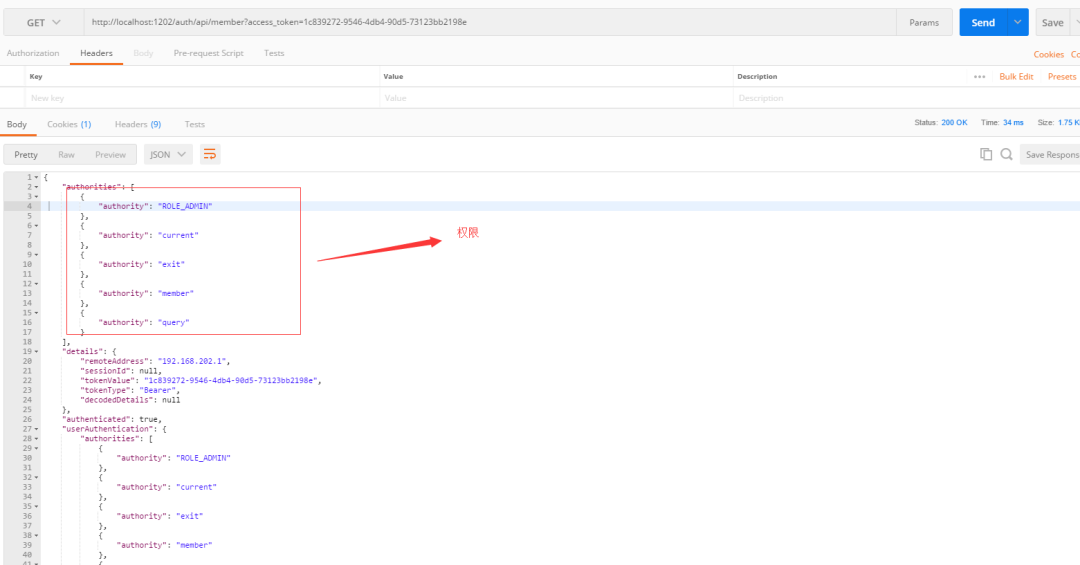
Using access_ The user information interface under the token request member service
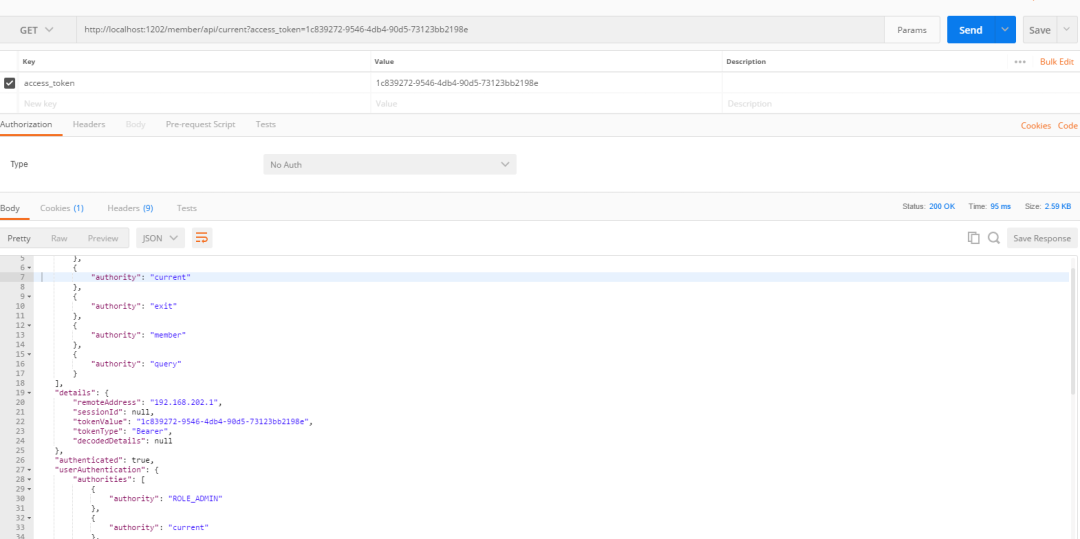
query interface for requesting member Service

The hello interface for requesting the member service does not give the user hello permission in the database

Refresh token
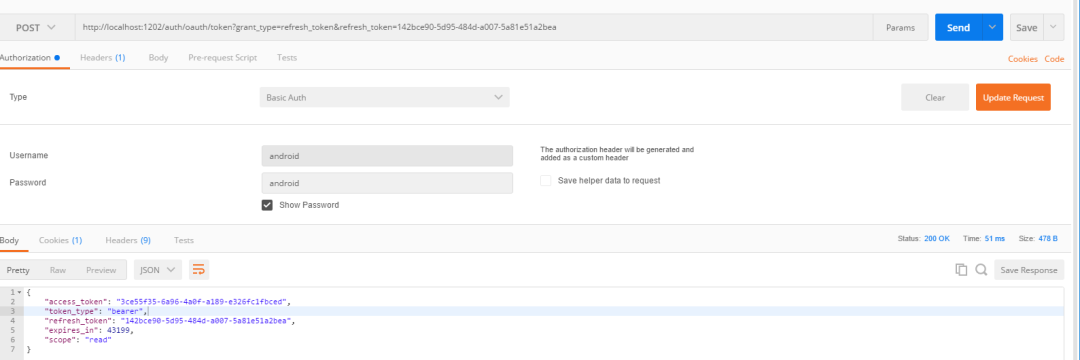
cancellation

The follow-up will be improved slowly. Please look forward to it!!
sql about the code and data table has been uploaded to GitHub. Address: https://github.com/WYA1993/springcloud_oauth2.0 .
Pay attention to replacing the database and redis with their own addresses
In a unified reply, many people reported that they returned 401 when obtaining authentication, as follows:
{
"timestamp": "2019-08-13T03:25:27.161+0000",
"status": 401,
"error": "Unauthorized",
"message": "Unauthorized",
"path": "/oauth/token"
}
The reason is that Basic Auth authentication was not added when the request was initiated, as shown in the following figure:
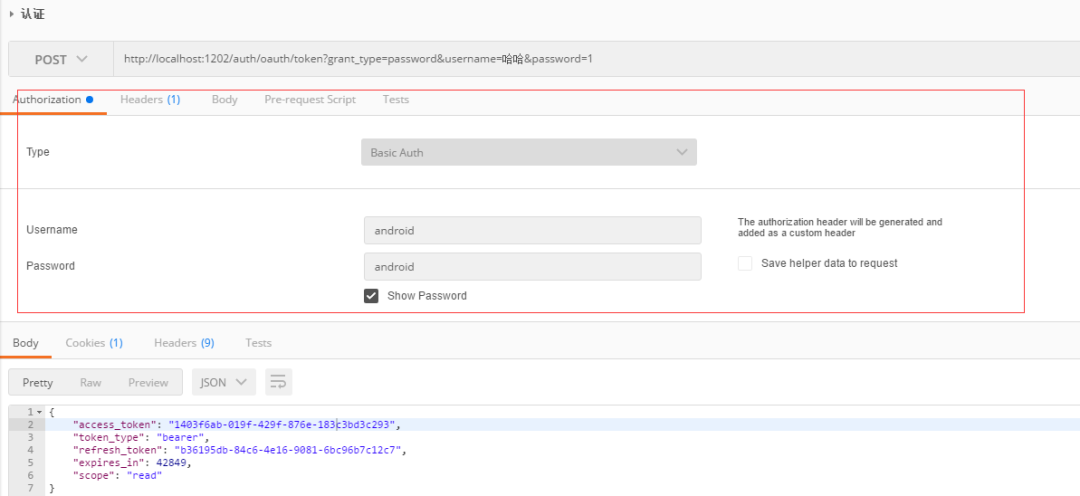
, after adding Basic Auth authentication, an authentication header will be added in the headers

The information of adding Basic Auth authentication is reflected in the code:

The client information and token information are obtained from the MySQL database
Now the client information is stored in memory, which is definitely not allowed in the production environment. To support the dynamic addition or deletion of the client, I choose to save the client information in MySQL.
First, create a data table. The structure of the data table has been officially given. The address is
https://github.com/spring-projects/spring-security-oauth/blob/master/spring-security-oauth2/src/test/resources/schema.sql
Secondly, you need to modify the sql script. Change the length of the primary key to 128 and the LONGVARBINARY type to blob. The adjusted sql script:
create table oauth_client_details ( client_id VARCHAR(128) PRIMARY KEY, resource_ids VARCHAR(256), client_secret VARCHAR(256), scope VARCHAR(256), authorized_grant_types VARCHAR(256), web_server_redirect_uri VARCHAR(256), authorities VARCHAR(256), access_token_validity INTEGER, refresh_token_validity INTEGER, additional_information VARCHAR(4096), autoapprove VARCHAR(256) ); create table oauth_client_token ( token_id VARCHAR(256), token BLOB, authentication_id VARCHAR(128) PRIMARY KEY, user_name VARCHAR(256), client_id VARCHAR(256) ); create table oauth_access_token ( token_id VARCHAR(256), token BLOB, authentication_id VARCHAR(128) PRIMARY KEY, user_name VARCHAR(256), client_id VARCHAR(256), authentication BLOB, refresh_token VARCHAR(256) ); create table oauth_refresh_token ( token_id VARCHAR(256), token BLOB, authentication BLOB ); create table oauth_code ( code VARCHAR(256), authentication BLOB ); create table oauth_approvals ( userId VARCHAR(256), clientId VARCHAR(256), scope VARCHAR(256), status VARCHAR(10), expiresAt TIMESTAMP, lastModifiedAt TIMESTAMP ); -- customized oauth_client_details table create table ClientDetails ( appId VARCHAR(128) PRIMARY KEY, resourceIds VARCHAR(256), appSecret VARCHAR(256), scope VARCHAR(256), grantTypes VARCHAR(256), redirectUrl VARCHAR(256), authorities VARCHAR(256), access_token_validity INTEGER, refresh_token_validity INTEGER, additionalInformation VARCHAR(4096), autoApproveScopes VARCHAR(256) );
The adjusted sql steps are also put into GitHub, and you can download them yourself if necessary

Then in eshop_ Create a data table in the member database and add the client information to OAuth_ client_ In the details table

If your password is not clear text, remember client_secret needs to be stored after encryption.
Then modify the code to configure the client information to be read from the database
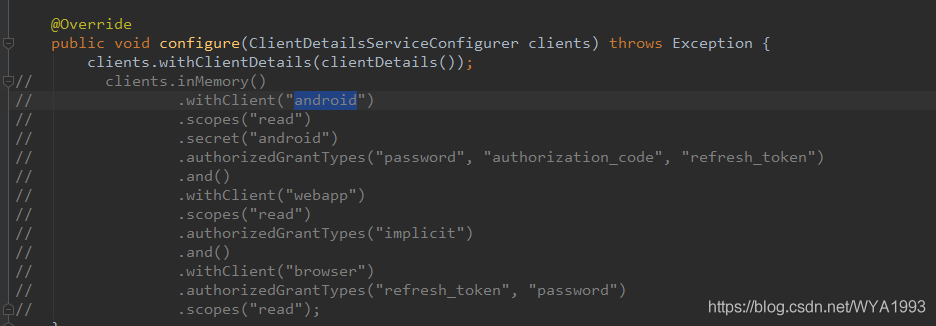
Next, start the service test.
Get authorization
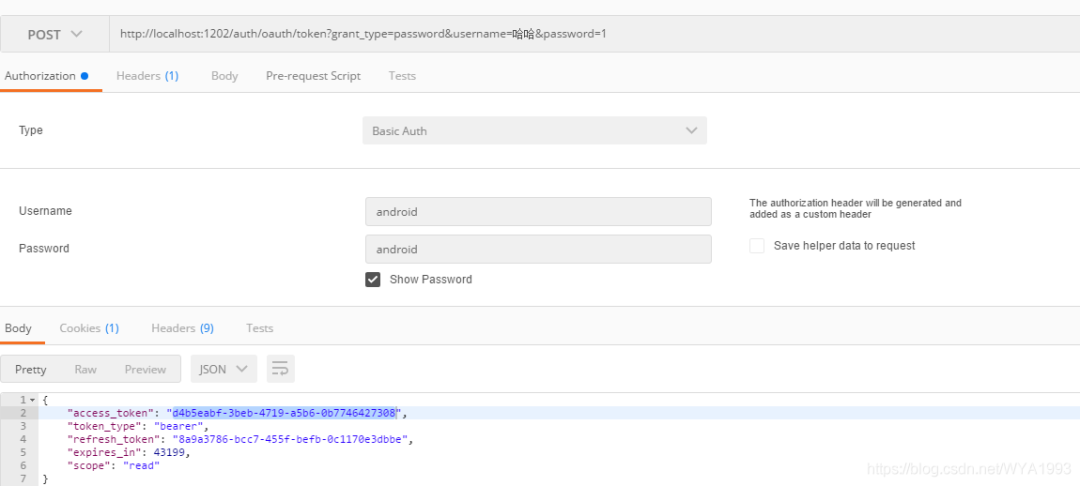
Get user information
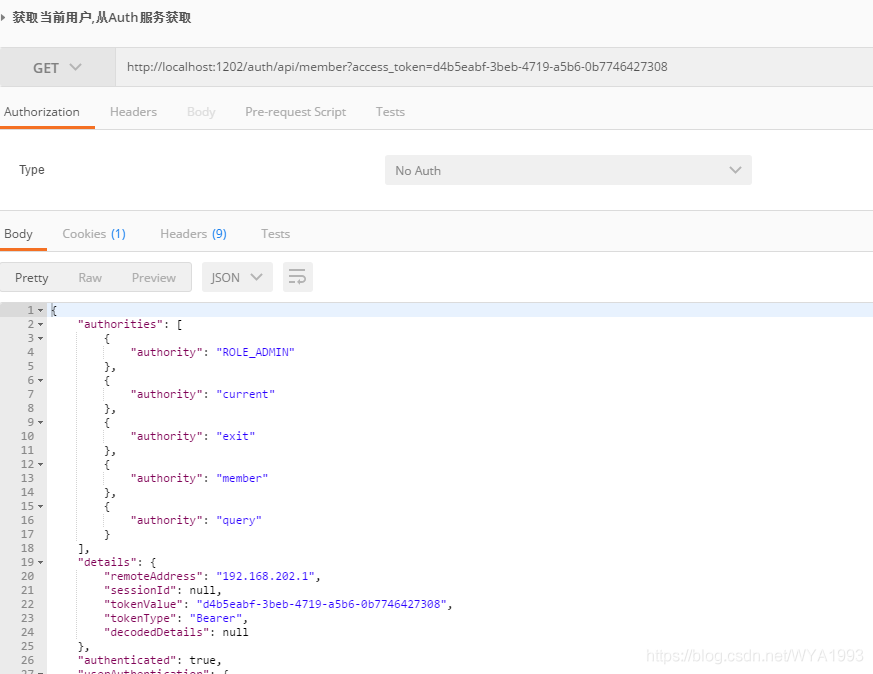
Refresh token

Open the data table and find that the token information is not saved in the table. Because the token store uses redis mode, we can read it from the database instead. Modify configuration
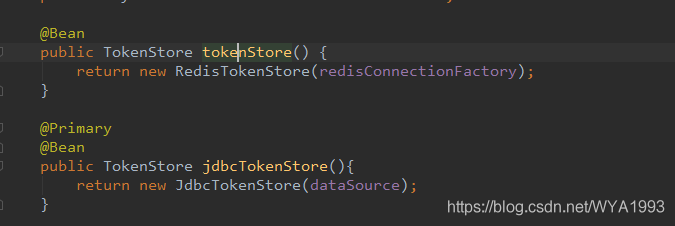
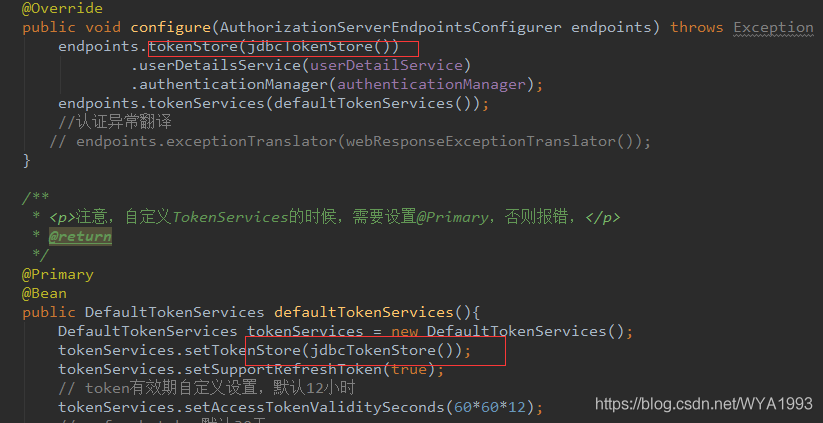
Restart the service and test again
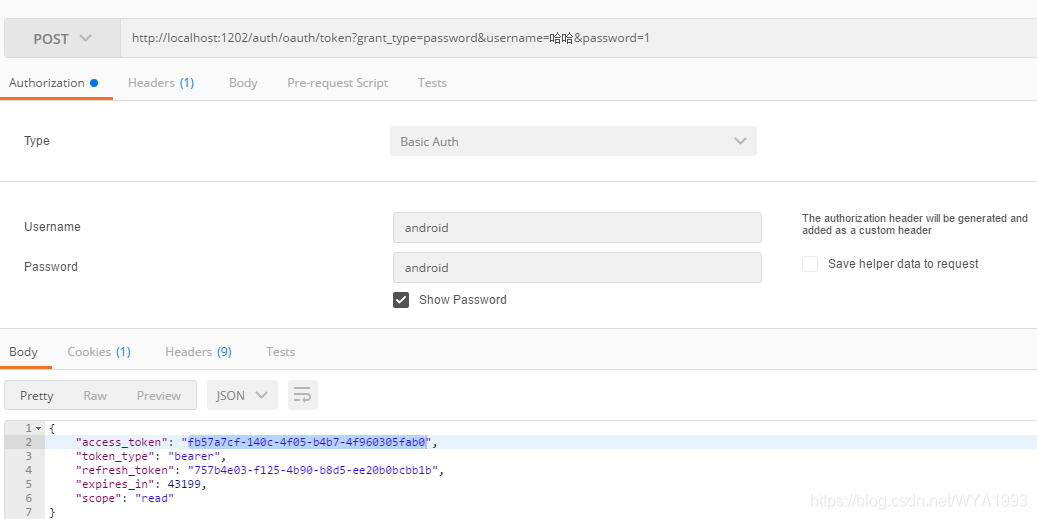
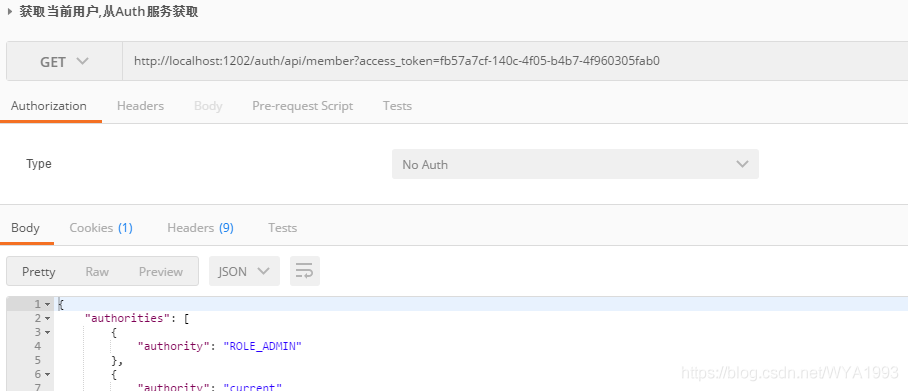
Check the data table and find that the token data has been saved in the table.


Source address: https://github.com/WYA1993/springcloud_oauth2.0 .
From: CSDN, author: myCat
Link: https://blog.csdn.net/WYA1993/article/details/85050120